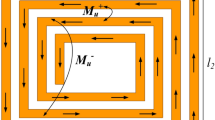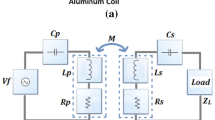Abstract
This paper presents a hybrid inductive link for Wireless Power Transfer (WPT) applications. Achieving better power transfer efficiency over a relatively wider distance across coils is the prime objective in most of the WPT systems, but often suffers from power loss in the near field area of inductively coupled coils. One of the reasons for this power loss is the pattern of the magnetic field produced by the source coil used in the WPT system. Mostly the nature of magnetic field produced by the source coil is distributed radially over the coil, in which the produced magnetic field is not fully utilized. Achieving better efficiency and load current by reducing power loss is the main driving force of this work. One of the viable methods to reduce the power loss is by increasing the field intensity thereby redirecting the flux lines flow to be directional. With this aim, three coils such as solenoid, spiral and conical are designed and simulated to determine the magnetic field strength using Finite Element Method. The conical coil produces the highest self-inductance of 8.63 µH and a field strength of 1.542 Wb with the coil thickness of 3.20 mm. Then, WPT system is demonstrated with the inclusion of Maximum Power Point Tracking algorithm for improving efficiency. The schematic of flux generation of both in the transmitter and receiver sections are demonstrated and analyzed graphically. The efficiency of both simulation and experimental measurements are matched well with similar progression. The effect of parameters (angle, distance, and load resistance) on the efficiency is explored. The outcomes conclude that the inductive coupling has achieved 73% (average case) power transfer wirelessly over a distance of 5 cm with an input voltage of 5 V and 5 MHz frequency.










Similar content being viewed by others
References
Schlierf R, Horst U, Ruhl M, Rode T S, Mokwa W and Schnakenberg U 2007 A fast telemetric pressure and temperature sensor system for medical applications. J. Micromech. Microeng. 17(7): 98–102
Ahmadi M M, and Jullien G A X 2009 A wireless-implantable microsystem for continuous blood glucose monitoring. IEEE Trans. Biomed Circuits Syst. 3(3): 169–180
Khan I M, Khan S, and Khalifa O O 2012 Wireless transfer of power to low power implanted biomedical devices coil design considerations. In: Instrumentation and Measurement Technology Conference, vol. 1, pp. 2584–2588
Kurs A, Karalis A, Moffatt R, Joannopoulos J D, Fisher P and Soljacic M 2003 Wireless power transfer via strongly coupled magnetic resonances. Science 80: 37–46
Kurs A and Lestoquoy G 2015 A framework for evaluating multi-kilowatt highly-resonant wireless power transfer systems. In: IEEE 82nd Vehicular Technology Conference (VTC Fall), Boston, MA, USA
Huh J, Lee S W, Lee W Y, Cho G H and Rim C T 2011 Narrow-width inductive power transfer system for online electrical vehicles. IEEE Trans. Power Electron. 26(12): 3666–3679
Budhia M, Covic G A and Boys J T 2011 Design and optimization of circular magnetic structures for lumped inductive power transfer systems. IEEE Trans. Power Electron. 26(11): 3096–3108
Nataraj C, Khan S, Habaebi M H, A G A Muthalif and R Lakshmanan 2017 Development of low power wireless power transfer system using resonance principle with security features. IIUM Eng. J. (IIUMEJ) 18(2):117–127
Van Thuan N, Kang S H, Choi J H, Jung C W 2015 Magnetic resonance wireless power transfer using three-coil system with single planar receiver for laptop applications. IEEE Trans. Consum. Electron. 61(2): 160–166
Bosshard R, Muhlethaler J, Kolar JW, and Stevanovic I 2013 Optimized magnetic design for inductive power transfer coils. In: Twenty Eighth Annual IEEE Applied Power Electronics Conference and Exposition, Long Beach, CA, USA
Torla A L, Khan S, Muthalif A G, Azman A W and Mustafah Y M 2013 Low voltage DC power supply with spike-blocking features. In: IEEE International Instrumentation and Measurement Technology Conference (I2MTC), Minneapolis, MN, USA
Nguyen M Q, Hughes Z, Woods P, Seo Y-S, Rao S, Chiao J-C 2014 Field distribution models of spiral coil for misalignment analysis in wireless power transfer systems. IEEE Trans. Microw. Theory Tech. 64(4): 920–930
Matias R, Cunha B and Martins R 2013 Modeling of inductive coupling for wireless power transfer to integrated circuits. In: IEEE Wireless Power Transfer, Perugia, Italy
Hwang H, Moon J, Lee B, Jeong C-H and Kim S-W 2014 An analysis of magnetic resonance coupling effects on wireless power transfer by coil inductance and placement. IEEE Trans. Consum. Electron. 60(2): 203–209
Bosshard R, Badstübner U, Kolar J W and Stevanovic I 2012 Comparative evaluation of control methods for inductive power transfer. In: International Conference on Renewable Energy Research and Applications, Nagasaki, Japan
Ng W M, Zhang C, Lin D, and Ron S Y 2014 Two- and three-dimensional omnidirectional wireless power transfer. IEEE Trans. Power Electron. 29(9): 4470–4474
Pantic Z, Lee K, and Lukic S M 2015 Receivers for multifrequency wireless power transfer: Design for minimum interference. IEEE J. Emerg. Sel. Top. Power Electron. 3(1): 234–241
Fotopoulou K, Flynn B W 2011 Wireless power transfer in loosely coupled links: coil misalignment model. IEEE Trans. Magn. 47(2): 416–430
Sun T, Xie X, Li G, Gu Y, Deng Y, Wang Z 2012 A two-hop wireless power transfer system with an efficiency-enhanced power receiver for motion-free capsule endoscopy inspection. IEEE Trans. Biomed. Eng. 59(11):3247–3254
Qiang H, Zhu W and Zheng J 2013 Simulation study on coil design of wireless power transfer system for optimal transmission efficiency. Res. J. Appl. Sci. Eng. Technol. 5(21): 5039–5041
Johari R, Krogmeier J V, and Love D J 2014 Analysis and practical considerations in implementing multiple transmitters for wireless power transfer via coupled magnetic resonance. IEEE Trans. Industr. Electron. 61(4): 1174–1783
Nataraj C, Khan S, Habaebi M H and Muthalif A G A 2016 Resonant coils analysis for inductively coupled wireless power transfer applications. In: IEEE International Instrumentation and Measurement Technology Conference, Taipei, Taiwan
Nataraj C, Khan S, Habaebi M H and Muthalif A G A 2016 Hybrid of Conical and Spiral Approach for Wireless Power Transfer. In: IEEE Student Conference on Research and Development (SCOReD), Kuala Lumpur, Malaysia
Dzung P Q, Le Dinh K, Lee H H, Phuong L M and Vu N T D 2010 The New MPPT Algorithm Using ANN-Based PV. In: IEEE International Forum on Strategic Technology (IFOST), Ulsan, Korea (South)
Author information
Authors and Affiliations
Corresponding author
Rights and permissions
About this article
Cite this article
NATARAJ, C., KHAN, S. & HABAEBI, M.H. Coil geometry models for power loss analysis and hybrid inductive link for wireless power transfer applications. Sādhanā 43, 67 (2018). https://doi.org/10.1007/s12046-018-0842-x
Received:
Revised:
Accepted:
Published:
DOI: https://doi.org/10.1007/s12046-018-0842-x




